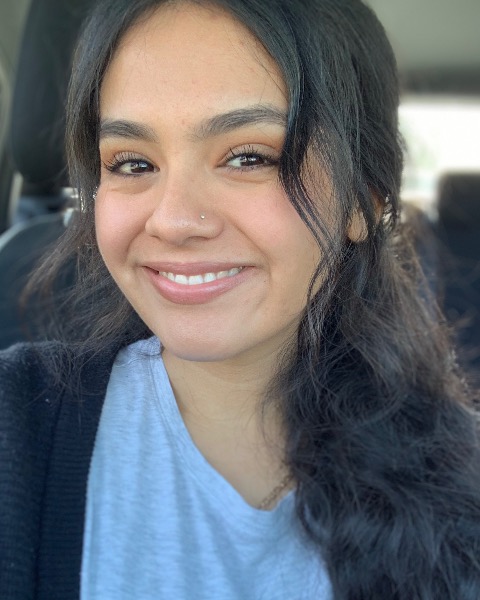Vestibular (V)
PP1511 - Frequency Tuning Characteristics of Bone-Conduction oVEMPs in Healthy Individuals

Isabel Valdovinos, BA (she/her/hers)
Student
California State University, Los Angeles
California State University, Los Angeles
Downey, CaliforniaFinancial Disclosures: I do not have any relevant financial relationships with anything to disclose.
Non-Financial Disclosures: I do not have any relevant non-financial relationships with anything to disclose.
Alaina Bassett, AuD, PhD (she/her/hers)
Assistant Professor
California State University, Los Angeles
Cal Sate Los Angeles
Seal Beach, CaliforniaFinancial Disclosures: I do not have any relevant financial relationships with anything to disclose.
Non-Financial Disclosures: Editorial Board Member, American Journal of Audiology
Review an article for the Journal of the American Academy of Audiology and Ear and Hearing- CS
Chandan H. Suresh, PhD (he/him/his)
Assistant Professor
California State Univeristy- Los Angeles
Alhambra CA 91803, CaliforniaFinancial Disclosures: I do not have any relevant financial relationships with anything to disclose.
Non-Financial Disclosures: I do not have any relevant non-financial relationships with anything to disclose.
Lead Presenter(s)
Presenter(s)
Ocular vestibular evoked myogenic potentials (oVEMPs) assess the function of the utricle and its associated afferent pathways of the superior vestibular nerve. The research project aims to understand the frequency tuning of bone conduction (BC) oVEMPs responses in healthy participants using a B-81 bone oscillator. Like previous research using air conduction stimulation and BC stimulation with a B-71 transducer, oVEMPs are 500Hz tuned responses with larger amplitude and lower thresholds. There was no incidence of responses 2,000 Hz. The study's findings of oVEMP tuning properties can be considered when diagnosing pathological conditions such as third window conditions (TWC).
Summary:
Learning Objective
Upon completion of this session the participant will be able to describe the frequency tuning of bone conduction ocular vestibular evoked myogenic potentials responses in healthy participants using a B-81 bone oscillator.
Rational/Purpose
Ocular vestibular evoked myogenic potentials (oVEMPs) assess the function of the utricle and its associated afferent pathways of the superior vestibular nerve. These are contralateral responses indicated by a negative excitatory peak (N1) at approximately 10ms and a positive peak (P1) at approximately 15ms. The clinical utility of oVEMPs include assessing the utricle and superior portion of the vestibular nerve in addition to testing for TWCs. Rosengren et al., (2019) reported that bone conduction (BC) oVEMPs might be a better screener for detecting TWC with high sensitivity and specificity than air conduction (AC) oVEMPs. Fröhlich et al., (2021) indicated that BC elicits higher amplitudes and lower thresholds of oVEMP than AC stimulation. BC is also the preferred mode of stimulation for patients with conductive pathologies. The newer B-81 bone oscillator creates less harmonic distortion and higher dynamic range at lower frequencies over the B-71 (Jansson et al., 2015). Frequency tuning is essential for differentiating normal and pathological conditions. This study aims to characterize the frequency tuning of BC oVEMP responses in healthy participants using a B-81 bone oscillator.
Methods
The study recruited participants with no history of neurologic disease, chronic noise exposure, vestibular disorders, and conductive hearing loss. For oVEMP recording, the positive electrode was placed on the right inner canalith, the negative electrode on the contralaterally inferior oblique, and the ground electrode on the sternum. oVEMP recording was performed while participants fixated on a point in the wall, approximately 60 cm from the participant at a 30-degree angle from an optimal gazing position. Tone burst stimuli were randomly presented at 500 Hz, 750 Hz, 1,000 Hz, 2,000 Hz, and 4,000 Hz. The initial intensity presentation was 75 dBnHL for 500 Hz, 750 Hz, 1,000 Hz, and 2,000 Hz, and 70 dBnHL for 4,000 Hz. The modified Hughson-Westlake method was utilized at each frequency to measure oVEMP thresholds. The average of two oVEMP recordings is considered for analysis. A two-minute break was provided between each stimuli presentation to prevent fatigue. The oVEMP response metrics, such as N1, P1 latency, and N1-P1 peak-to-peak amplitude, are considered for analysis.
Results
The preliminary findings indicated that oVEMPs were present in all participants between 500-1000 Hz. No participants had present oVEMPs between 2,000-4,000Hz. The responses had maximum amplitude, longer N1, and P1 latencies, and lowest thresholds at 500 Hz than other frequencies evaluated. The average threshold at 500 Hz, 750 Hz, 1,000 Hz were 65 dBnHL, 71 dBnHL, and 73 dBnHL respectively. The average amplitude at the high-intensity presentation is approximately three times bigger at 500Hz compared to 1000Hz.
Conclusion
Like previous studies using AC stimulation and BC stimulation with B-71, oVEMPs are 500 Hz tuned responses and no incidence of responses 2,000 Hz. The study's findings can be considered when diagnosing pathological conditions such as TWC.
Learning Objectives:
- Upon completion of this session participants will be able to describe the frequency tuning of bone conduction oVEMPs responses in healthy participants using a B-81 bone oscillator.
